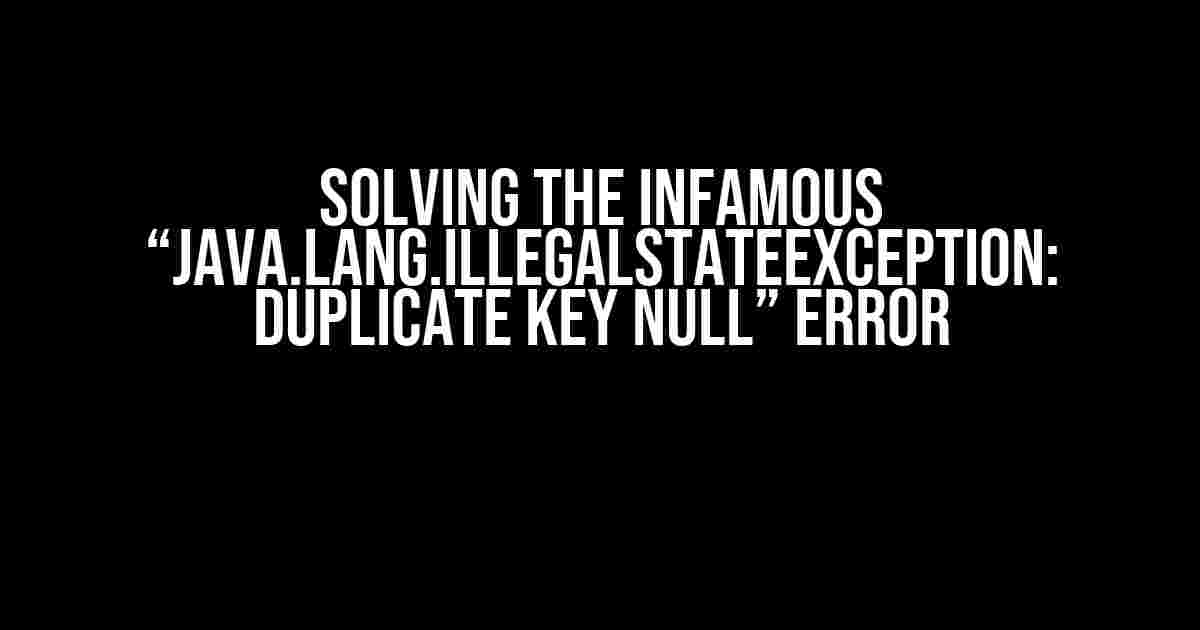Ah, the dreaded “java.lang.IllegalStateException: Duplicate key null” error. You’ve probably encountered it while working on a Java-based project, and it’s left you scratching your head. Don’t worry, you’re not alone! In this article, we’ll delve into the depths of this error, explore its causes, and provide step-by-step solutions to get you back on track.
The Anatomy of the Error
The “java.lang.IllegalStateException: Duplicate key null” error typically occurs when your Java application attempts to merge duplicate keys in a Map or a similar data structure. But what exactly does this error message mean?
java.lang.IllegalStateException: Duplicate key null
at java.util.HashMap.putVal(HashMap.java:663)
at java.util.HashMap.put(HashMap.java:611)
at com.example.MyClass.mergeData(MyClass.java:123)
...
Breaking it down:
java.lang.IllegalStateException: This is the type of exception being thrown, indicating an illegal state or operation.Duplicate key null: The error message explicitly states that there’s a duplicate key with a value of null.(attempted merging values 0 and 1): This part hints at the root cause – the application is trying to merge two values (0 and 1) with the same null key.
Causes of the Error
Now that we’ve dissected the error message, let’s explore the common scenarios that lead to this exception:
- Null keys in a Map: When you attempt to store a null key in a Map, it can result in duplicate keys, causing the error.
- Improper data processing: If your application processes data in a way that introduces duplicate keys, you’ll encounter this error.
- Concurrent modifications: In multithreaded environments, concurrent modifications to a shared data structure can lead to duplicate keys and, subsequently, the error.
- Serialization and deserialization issues: During serialization and deserialization, if the data is not properly handled, it can result in duplicate keys, causing the error.
Solutions to the Error
Now that we’ve covered the causes, let’s dive into the solutions:
Solution 1: Avoid Null Keys in Maps
A simple yet effective solution: avoid using null keys in your Maps. Instead, use a default or sentinel value to represent the absence of a key.
Map<String, Integer> myMap = new HashMap<>();
myMap.put("key", 1); // good
myMap.put(null, 1); // bad, will throw the error
myMap.put("defaultKey", 1); // good, use a default key
Solution 2: Handle Duplicates During Data Processing
When processing data, ensure that you handle duplicates correctly. You can use various techniques, such as:
- Using a
Setto store unique keys - Implementing a custom merge strategy for duplicate keys
- Removing duplicates before storing the data
Set<String> uniqueKeys = new HashSet<>(); // ... uniqueKeys.add(key); // adds only unique keys
Solution 3: Synchronize Access to Shared Data Structures
In multithreaded environments, ensure that access to shared data structures is properly synchronized. You can use:
synchronizedblocks or methodsConcurrentHashMapor other thread-safe data structures- LOCKS or other synchronization mechanisms
synchronized (myMap) {
myMap.put(key, value); // safe, synchronized access
}
Solution 4: Handle Serialization and Deserialization Correctly
When serializing and deserializing data, ensure that:
- You use a proper serialization mechanism (e.g., Java Serialization, JSON, etc.)
- You handle null values correctly during serialization and deserialization
- You use a versioning system to ensure compatibility between different data versions
// Using Java Serialization ObjectOutputStream outputStream = new ObjectOutputStream(fileOutputStream); outputStream.writeObject(myObject);
Conclusion
The “java.lang.IllegalStateException: Duplicate key null” error can be frustrating, but by understanding its causes and following the solutions outlined in this article, you’ll be well-equipped to tackle this issue head-on. Remember to:
- Avoid null keys in Maps
- Handle duplicates during data processing
- Synchronize access to shared data structures
- Handle serialization and deserialization correctly
By following these guidelines, you’ll be able to resolve the “java.lang.IllegalStateException: Duplicate key null” error and ensure the stability and reliability of your Java-based applications.
[table]
| Cause | Solution |
| — | — |
| Null keys in Maps | Avoid null keys, use default or sentinel values |
| Improper data processing | Handle duplicates during data processing, use Sets or custom merge strategies |
| Concurrent modifications | Synchronize access to shared data structures, use thread-safe data structures |
| Serialization and deserialization issues | Handle null values correctly, use proper serialization mechanisms |
[/table]
Keep calm, debug on, and happy coding!
Frequently Asked Question
Get answers to the most common questions about “java.lang.IllegalStateException: Duplicate key null (attempted merging values 0 and 1)” error!
What is the “java.lang.IllegalStateException: Duplicate key null” error?
The “java.lang.IllegalStateException: Duplicate key null” error occurs when you’re trying to merge two or more values with a null key, which is not allowed. This error is commonly seen in Java-based applications, especially when working with HashMaps or other data structures.
Why does this error occur?
This error occurs because the Java compiler is trying to prevent unexpected behavior in your code. When you try to merge values with a null key, it can lead to unpredictable results and potential bugs. By throwing this exception, Java forces you to handle the null key scenario properly.
How do I fix the “java.lang.IllegalStateException: Duplicate key null” error?
To fix this error, you need to handle the null key scenario properly. You can do this by checking for null values before adding them to your data structure. You can also use a default value or a custom key generator to avoid null keys.
What are some common scenarios where this error occurs?
This error commonly occurs when working with HashMaps, HashTables, or other data structures that use key-value pairs. It can also occur when using Java Stream APIs, especially when grouping or collecting data.
Can I ignore this error or continue executing my code?
No, it’s not recommended to ignore this error or continue executing your code. This error indicates a potential bug or unexpected behavior in your code. Ignoring it can lead to further errors, data corruption, or even security vulnerabilities. Instead, take the time to fix the issue and ensure your code is robust and reliable.
